Fujitsu Servers: Autumn Update
Surely almost every one of you, like us, has encountered an avalanche-like growth of data, and realized that you should not expect to stop or slow down this process in the near future. Currently, applications are working actively with data, for example, in such areas as business analytics and BigData Mining. Their use requires serious server resources and elimination of bottlenecks in drives and communications.

Fujitsu, having a large and in many ways unique experience in server development and understanding the needs and tasks of its customers, releases timely solutions that effectively solve current tasks and have a sufficiently large reserve for the future, as evidenced by repeated world performance records:
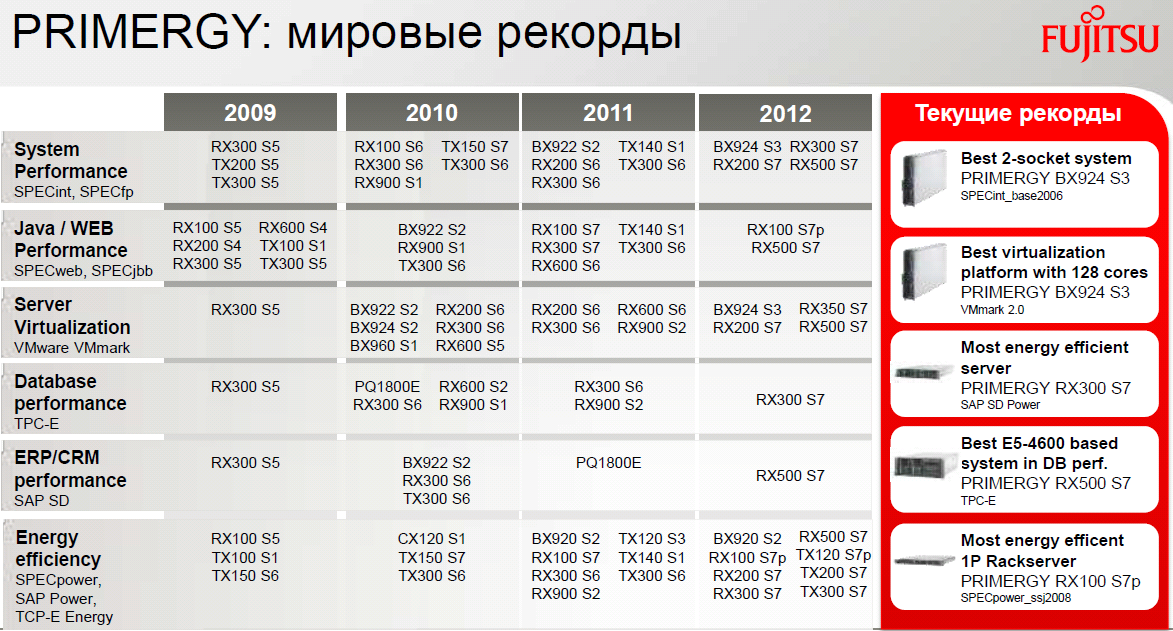
Moreover, the dual-processor servers of the S8 generation came out just a month ago, but already managed to set new records:
')
Many, often not without reason, are skeptical of such “numbers on the Internet”, so Fujitsu is ready to show the customer similar results on equipment from the demo fund, in order to dispel possible doubts.
In the server line Fujitsu you can find almost everything: from a microserver to a mainframe. Its update is connected, first of all, with the upgrade by Intel of its Intel Xeon E5-2600 series server processors to version v2, as well as Intel Xeon E3-1200 series processors to version v3. It affected the following Fujitsu PRIMERGY servers (by family):
Recall that in the Intel Xeon E5-2600 v2 processors, a transition was made from the Sandy Bridge-EP microarchitecture to the Ivy Bridge-EP microarchitecture. The latter is well known to all of us from single-processor servers, desktop and mobile PCs, where it has been used for a long time and is being supplanted at the moment by the Haswell architecture. The Ivy Bridge-EP architecture is distinguished, first of all, by a thinner manufacturing process (22 nm). In addition, there were models of processors with 12 processing cores, which gave a fairly good performance jump (Sandy Bridge-EP had no more than 8 cores), the maximum third-level cache increased to 30 MB (there were 20), memory support appeared 1866 MHz (was 1600) and power consumption in idle mode was reduced to 10.5 W against 15 W in the previous line.
Another important change was the support of memory modules of 64 GB, with which it became possible to use up to 1536 GB of RAM in dual-processor servers! Unfortunately, the cost of each such module at the moment is comparable to the cost of a good server. However, using 32 GB modules, it is quite possible to get a 768 GB volume for a dual-processor server. Although the price of such modules is still quite high (one 32 GB module costs approximately like 3 modules of 16 GB each), but it turns out to be quite lifting if the real task is to provide a large amount of RAM. By the way, if it's not difficult, please share in the comments what maximum amount of RAM you have used in your servers (they are interested, first of all, in dual-processor ones, but also the others) and for what tasks.
Intel Xeon E3-1200 v3 processors are focused on single-processor solutions, they are built on the Haswell microarchitecture. This processor architecture differs from the previous one (Ivy Bridge) in some optimizations of the computational cores, in particular, in support of new AVX 2.0 instructions, which made it possible to increase performance on average by about 8.5% for processors with the same clock speed characteristics. A comparison of the speed of performing integer operations and floating point operations of Intel Xeon Processor E3-1200 processors of all three generations can be seen in the graph below:
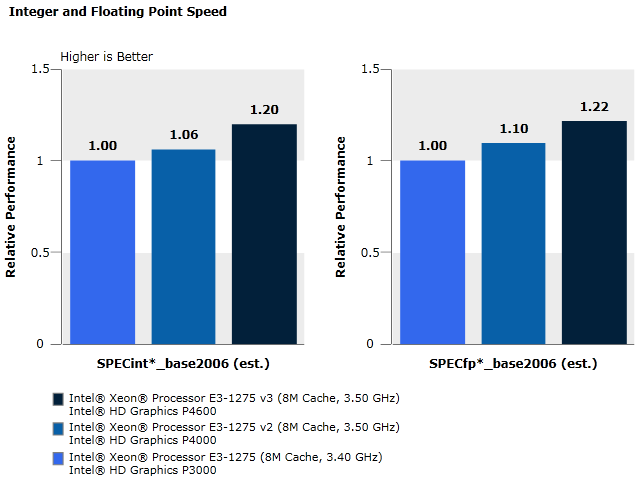
As you can see, there is undoubtedly a performance boost, but within a single-processor server this may not be very noticeable (especially if compared with the previous generation, and not with the very first).
Upgrading processors is not the only change in new servers. Another important innovation is the use of Fujitsu Cool-safe Advanced Thermal Design (ATD) technology. This is Fujitsu's approach to the internal design of servers, extending their operating temperature range by 5 degrees in both directions. Now the permissible operating ambient temperature for such equipment is from + 5 ° C to + 40 ° C (for servers of previous generations, the range was + 10 ° C - + 35 ° C). At the same time, the most important task of Cool-safe ATD is to ensure continuous operation of servers in the entire operating range without time limitation. Those. you will not have to even briefly change the ambient temperature or reduce the performance of the server itself to cool it. This factor is, in fact, very important. For example, according to Gartner's research, the temperature increase in the data center by 5 degrees saves up to 27% on server cooling (data for Europe). And in the conditions of Russian reality, it allows you to install a number of such servers in server rooms with natural air conditioning, or use less powerful cooling systems. The cost of heat dissipation is something to save on, and in many respects thanks to Fujitsu. In our opinion, this is a clear argument for any leader.
In addition to the expansion of operating temperatures, the energy efficiency of the servers themselves also increases. So, according to the java operation per watt tests (SPECpower_ssj2008), the new servers show up to 50% performance increase per watt, which corresponds to a 35% performance increase while maintaining the level of energy consumption. This was achieved through the introduction of new power supplies with an efficiency of 96% (80Plus Titanium certification), improvements at the system level (BIOS and Firmware components), simplification of power management in ServerView (this is the name of our family of software for conveniently managing Fujitsu servers throughout life) cycle).
New servers offer a new level of SSD performance. To do this, some models (RX 300 S8 and RX350 S8) can have a Fujitsu PRAID EP400i RAID controller with support for the latest 12 Gb / s SAS interface, as well as corresponding SSDs. In addition, support for PCIe SSD 2.5˝ is expected in the near future. These drives look like a regular SSD 2.5˝, but have a PCI-Express interface, respectively, they require a basket with a special backplane with a direct connection to the PCIe bus. Using only the SAS 12Gb / s interface allows you to achieve a serious increase in the number of I / O operations per second (IOPS) for SSD compared to the previous generation, and the gain from the introduction of PCIe drives will be even greater:
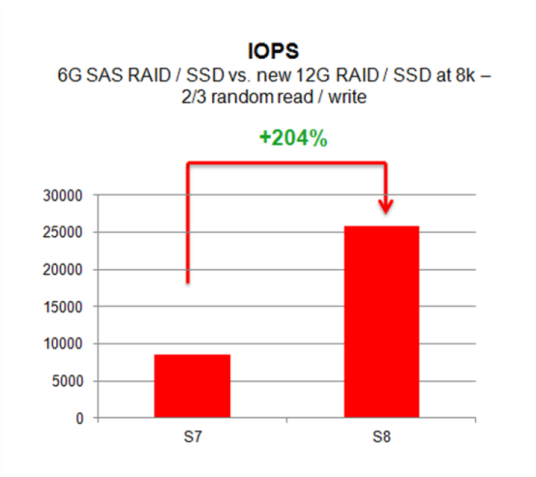
Thus, the response time for the disk subsystem is reduced, which allows for greater performance for solutions with high I / O requirements: databases, business analytics, VDI, etc. Here you can also recall the vSAN technology that our global partner announced VMware is the latest version of the vSphere 5.5 virtualization platform. When using it, such performance of the local disk subsystem will be very useful.
The integrated remote access controller (iRMC), which provides server interaction with Fujitsu ServerView, was also updated . Its new version S4 has a video memory capacity increased to 256 MB, supports monitoring of RAID and disks regardless of the OS state (even if the OS is not loaded or “stuck”). Also in it appeared the option of recording video, which works including. before loading the OS, and support for CIM (Common Information Model).
Some new server models also support nVidia Tesla K20 / K20X and Intel Xeon Phi computing accelerators, which are actively distributed in the HPC segment. In general, HPC clusters are one of the areas where Fujitsu positions are traditionally strong. Also in the new line appears support for NVIDIA Grid K1 cards, certified for use with Citrix XenDesktop, which provide hardware-based GPU virtualization and opportunities for VDI.
In conclusion, we present the characteristics of the updated servers. In order not to bore you with a tedious list of characteristics, in which it is easy to get confused, we have compiled the corresponding labels (in bold they highlight the key differences from the models of the previous generation). In this form, this information seems to us more useful.
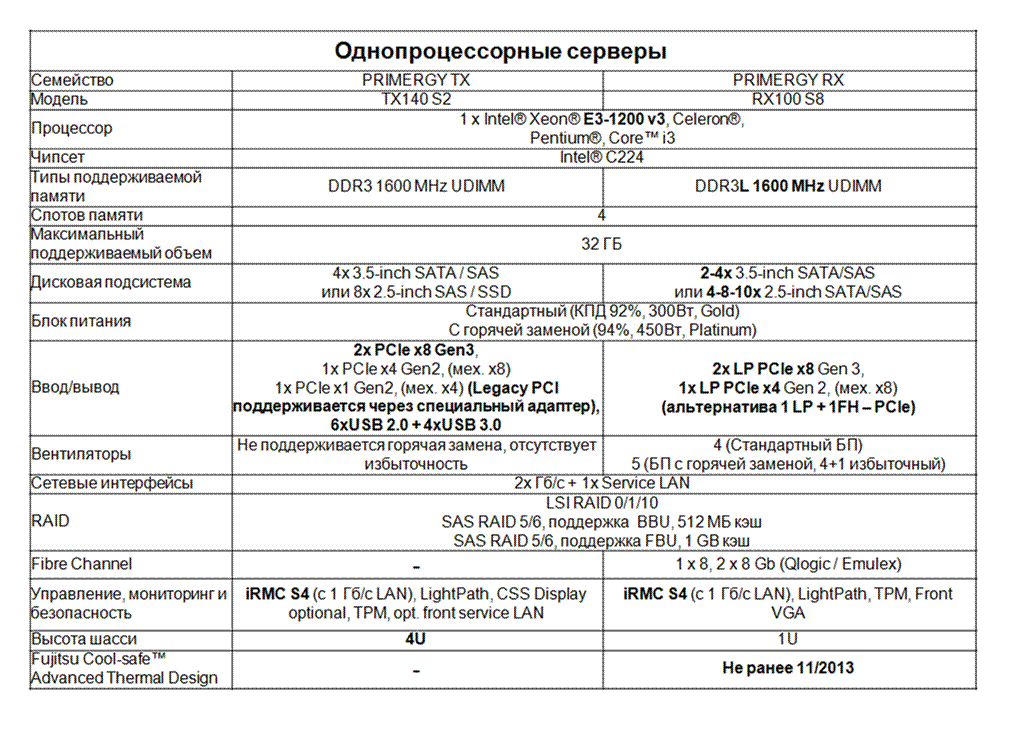
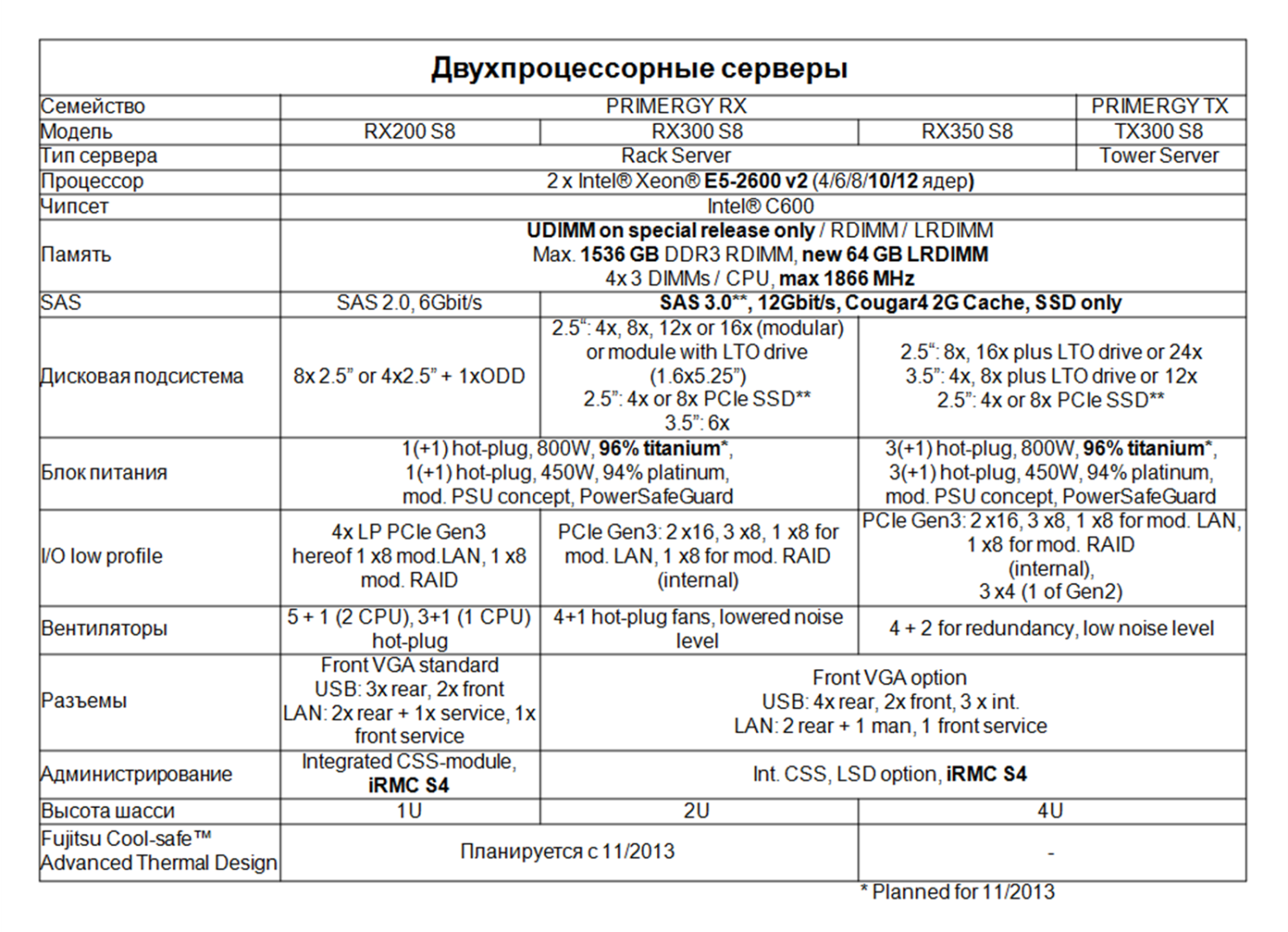


Fujitsu, having a large and in many ways unique experience in server development and understanding the needs and tasks of its customers, releases timely solutions that effectively solve current tasks and have a sufficiently large reserve for the future, as evidenced by repeated world performance records:

Moreover, the dual-processor servers of the S8 generation came out just a month ago, but already managed to set new records:
')
- PRIMERGY RX300 S8 - a new world record for energy efficiency - 8.097 overall ssj_ops / watt1; 7.46 watts / kilo SAPS2
- PRIMERGY RX350 S8 - a new record for system performance - SPECfp_base 2006 = 109
- PRIMERGY RX300 S8 - a new record in the two-stage SAP SD test among dual-processor servers - 10.240 SAP SD Benchmark users
Many, often not without reason, are skeptical of such “numbers on the Internet”, so Fujitsu is ready to show the customer similar results on equipment from the demo fund, in order to dispel possible doubts.
In the server line Fujitsu you can find almost everything: from a microserver to a mainframe. Its update is connected, first of all, with the upgrade by Intel of its Intel Xeon E5-2600 series server processors to version v2, as well as Intel Xeon E3-1200 series processors to version v3. It affected the following Fujitsu PRIMERGY servers (by family):
- TX - inexpensive floor servers for small infrastructures - the changes affected the single-processor PRIMERGY TX140 generation S2, as well as quite powerful and flexible in configuring the two-processor PRIMERGY TX300 generation S8;
- RX - universal powerful and energy-efficient rack servers - the PRIMERGY RX100 single-processor server and the PRIMERGY RX200, RX300 and RX350 dual-processor servers (all S8 generation models) have been updated;
- BX - compact scalable blades - this family has updated the PRIMERGY BX924 dual-processor blade to S4 generation;
- CX - high-density server infrastructure (several independent computational nodes (nodes) in one server chassis provide more power with the same or less space) - in September of this year. The new PRIMERGY CX400 chassis and the CX250 and CX270 generation S2 dual-processor computing nodes were introduced.
Recall that in the Intel Xeon E5-2600 v2 processors, a transition was made from the Sandy Bridge-EP microarchitecture to the Ivy Bridge-EP microarchitecture. The latter is well known to all of us from single-processor servers, desktop and mobile PCs, where it has been used for a long time and is being supplanted at the moment by the Haswell architecture. The Ivy Bridge-EP architecture is distinguished, first of all, by a thinner manufacturing process (22 nm). In addition, there were models of processors with 12 processing cores, which gave a fairly good performance jump (Sandy Bridge-EP had no more than 8 cores), the maximum third-level cache increased to 30 MB (there were 20), memory support appeared 1866 MHz (was 1600) and power consumption in idle mode was reduced to 10.5 W against 15 W in the previous line.
Another important change was the support of memory modules of 64 GB, with which it became possible to use up to 1536 GB of RAM in dual-processor servers! Unfortunately, the cost of each such module at the moment is comparable to the cost of a good server. However, using 32 GB modules, it is quite possible to get a 768 GB volume for a dual-processor server. Although the price of such modules is still quite high (one 32 GB module costs approximately like 3 modules of 16 GB each), but it turns out to be quite lifting if the real task is to provide a large amount of RAM. By the way, if it's not difficult, please share in the comments what maximum amount of RAM you have used in your servers (they are interested, first of all, in dual-processor ones, but also the others) and for what tasks.
Intel Xeon E3-1200 v3 processors are focused on single-processor solutions, they are built on the Haswell microarchitecture. This processor architecture differs from the previous one (Ivy Bridge) in some optimizations of the computational cores, in particular, in support of new AVX 2.0 instructions, which made it possible to increase performance on average by about 8.5% for processors with the same clock speed characteristics. A comparison of the speed of performing integer operations and floating point operations of Intel Xeon Processor E3-1200 processors of all three generations can be seen in the graph below:

As you can see, there is undoubtedly a performance boost, but within a single-processor server this may not be very noticeable (especially if compared with the previous generation, and not with the very first).
Upgrading processors is not the only change in new servers. Another important innovation is the use of Fujitsu Cool-safe Advanced Thermal Design (ATD) technology. This is Fujitsu's approach to the internal design of servers, extending their operating temperature range by 5 degrees in both directions. Now the permissible operating ambient temperature for such equipment is from + 5 ° C to + 40 ° C (for servers of previous generations, the range was + 10 ° C - + 35 ° C). At the same time, the most important task of Cool-safe ATD is to ensure continuous operation of servers in the entire operating range without time limitation. Those. you will not have to even briefly change the ambient temperature or reduce the performance of the server itself to cool it. This factor is, in fact, very important. For example, according to Gartner's research, the temperature increase in the data center by 5 degrees saves up to 27% on server cooling (data for Europe). And in the conditions of Russian reality, it allows you to install a number of such servers in server rooms with natural air conditioning, or use less powerful cooling systems. The cost of heat dissipation is something to save on, and in many respects thanks to Fujitsu. In our opinion, this is a clear argument for any leader.
In addition to the expansion of operating temperatures, the energy efficiency of the servers themselves also increases. So, according to the java operation per watt tests (SPECpower_ssj2008), the new servers show up to 50% performance increase per watt, which corresponds to a 35% performance increase while maintaining the level of energy consumption. This was achieved through the introduction of new power supplies with an efficiency of 96% (80Plus Titanium certification), improvements at the system level (BIOS and Firmware components), simplification of power management in ServerView (this is the name of our family of software for conveniently managing Fujitsu servers throughout life) cycle).
New servers offer a new level of SSD performance. To do this, some models (RX 300 S8 and RX350 S8) can have a Fujitsu PRAID EP400i RAID controller with support for the latest 12 Gb / s SAS interface, as well as corresponding SSDs. In addition, support for PCIe SSD 2.5˝ is expected in the near future. These drives look like a regular SSD 2.5˝, but have a PCI-Express interface, respectively, they require a basket with a special backplane with a direct connection to the PCIe bus. Using only the SAS 12Gb / s interface allows you to achieve a serious increase in the number of I / O operations per second (IOPS) for SSD compared to the previous generation, and the gain from the introduction of PCIe drives will be even greater:

Thus, the response time for the disk subsystem is reduced, which allows for greater performance for solutions with high I / O requirements: databases, business analytics, VDI, etc. Here you can also recall the vSAN technology that our global partner announced VMware is the latest version of the vSphere 5.5 virtualization platform. When using it, such performance of the local disk subsystem will be very useful.
The integrated remote access controller (iRMC), which provides server interaction with Fujitsu ServerView, was also updated . Its new version S4 has a video memory capacity increased to 256 MB, supports monitoring of RAID and disks regardless of the OS state (even if the OS is not loaded or “stuck”). Also in it appeared the option of recording video, which works including. before loading the OS, and support for CIM (Common Information Model).
Some new server models also support nVidia Tesla K20 / K20X and Intel Xeon Phi computing accelerators, which are actively distributed in the HPC segment. In general, HPC clusters are one of the areas where Fujitsu positions are traditionally strong. Also in the new line appears support for NVIDIA Grid K1 cards, certified for use with Citrix XenDesktop, which provide hardware-based GPU virtualization and opportunities for VDI.
In conclusion, we present the characteristics of the updated servers. In order not to bore you with a tedious list of characteristics, in which it is easy to get confused, we have compiled the corresponding labels (in bold they highlight the key differences from the models of the previous generation). In this form, this information seems to us more useful.



Source: https://habr.com/ru/post/198844/
All Articles